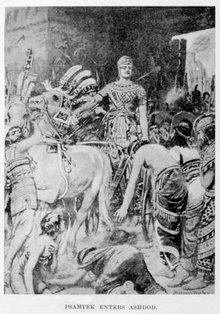Fall of Ashdod
| Fall of Ashdod | |||||||
|---|---|---|---|---|---|---|---|
| Part of the Wars of Neo-Assyria | |||||||
 Psamtik I enters Ashdod | |||||||
| |||||||
| Belligerents | |||||||
|
Twenty-sixth dynasty of Egypt |
Neo-Assyrian empire | ||||||
| Commanders and leaders | |||||||
|
Psammetichus I | Unknown | ||||||
| Strength | |||||||
| Unknown | Unknown | ||||||
| Casualties and losses | |||||||
| Unknown | Unknown | ||||||
The Fall of Ashdod was the successful
Philistine pentapolis, located in southwestern Canaan, about 655 BC.[3] According to the Greek historian Herodotus, pharaoh Psamtik I, besieged Ashdod for 29 years. Ashdod had lost most of its inhabitants during those long years of siege.[4]
Background
Prior to the death of King
Elam
. However, this left Egypt more or less unchecked.
Capture of Ashdod
Despite the previous hostility between the two powers, it appears that the Assyrians and the Egyptians did not go to war.Egyptian 26th Dynasty.
References
- ^ "Psammetichus ruled Egypt for fifty-three years, twenty-nine of which he spent before Azotus, a great city in Syria, besieging it until he took it."Herodotus, The Histories [1], (II, 157)
- ^ "the Egyptian pharaoh Psammetichus i conquered the city after a siege of 29 years""Ashdod". encyclopedia.com.
- ^ "In 655 BCE Psamtik I marched into Philistia""The Late period (664–332 BCE)".
- ^ Herodotus, (II, 157)
- ^ Healy, Mark (1991). The Ancient Assyrians. New York: Osprey. p. 52.
- ^ Healy, Mark (1991). The Ancient Assyrians. New York: Osprey. p. 54.
